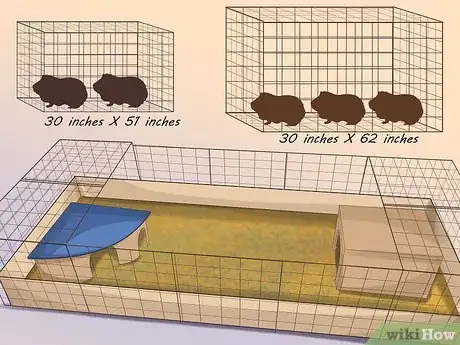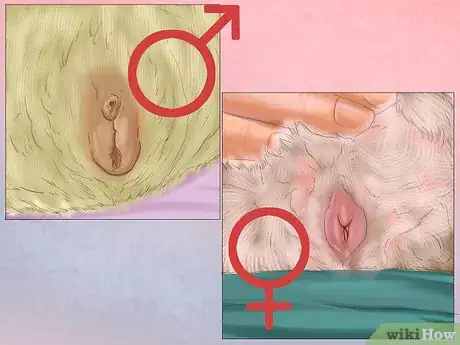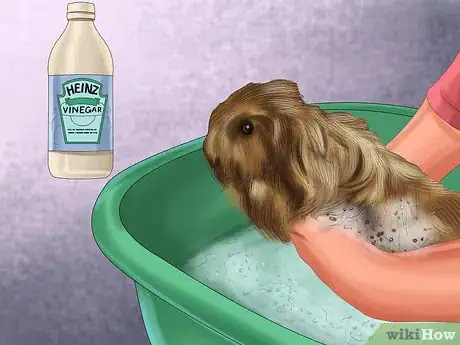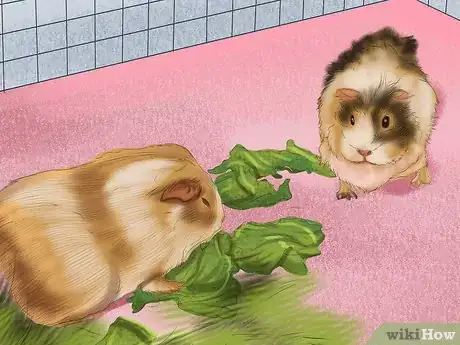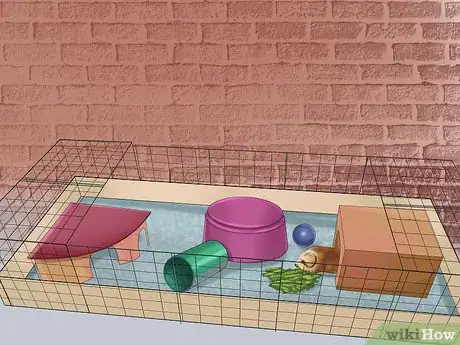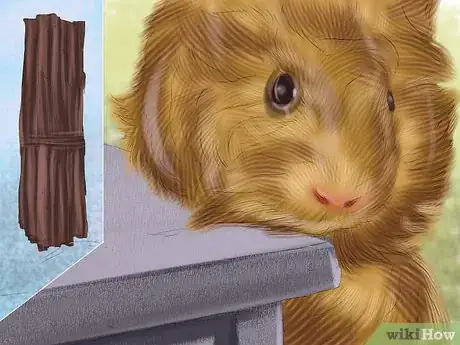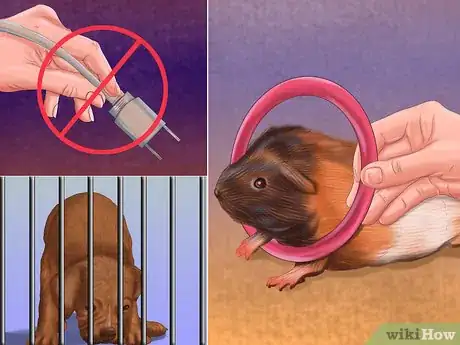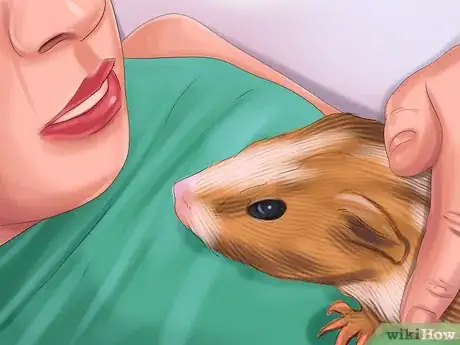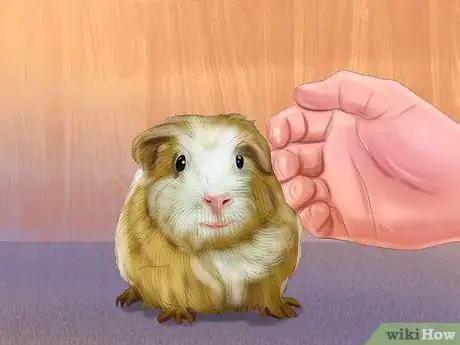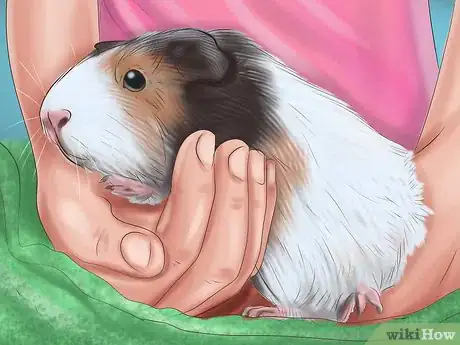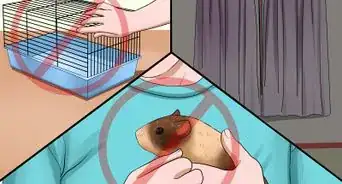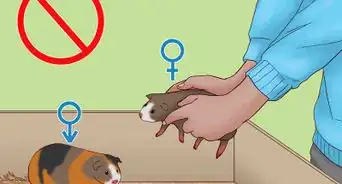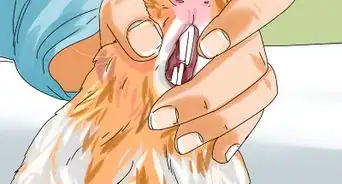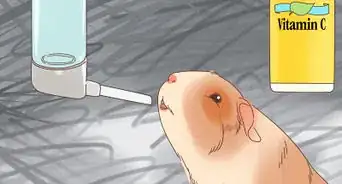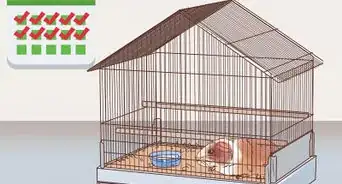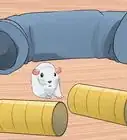This article was co-authored by Pippa Elliott, MRCVS. Dr. Elliott, BVMS, MRCVS is a veterinarian with over 30 years of experience in veterinary surgery and companion animal practice. She graduated from the University of Glasgow in 1987 with a degree in veterinary medicine and surgery. She has worked at the same animal clinic in her hometown for over 20 years.
There are 15 references cited in this article, which can be found at the bottom of the page.
wikiHow marks an article as reader-approved once it receives enough positive feedback. In this case, 86% of readers who voted found the article helpful, earning it our reader-approved status.
This article has been viewed 52,674 times.
Guinea pigs are cute little animals that make great pets. They’re fun to cuddle with and are very social.[1] However, different situations can make guinea pigs feel anxious and stressed, which may not make them not as fun to play with. If your guinea pig feels anxious, find ways to relieve this anxiety make him a happy guinea pig again.
Steps
Giving Your Guinea Pig a Cage Mate
-
1Purchasing a larger cage may be necessary if your cage is not already 7.5 square feet. Guinea pigs are naturally social animals and do best in a pair or within a small group. Simply put, guinea pigs need to be with other guinea pigs! However, having a cage mate won’t relieve your guinea pig’s anxiety very much if the cage is too small. The ideal cage size for two guinea pigs is 30 by 51 inches (75 cm by 130 cm).[2]
- For three guinea pigs, the cage should be at least 30 by 62 inches (76 by 160 cm). Four guinea pigs should be housed in a cage that is at least 30 by 76 inches (76 by 193 cm).[3] As a general rule, take the number of guinea pigs, multiply it by four, and that will give you the recommended square footage.
- If the cages in your local pet store are not large enough, you may need to build your own cage. Visit your local home improvement store to purchase the supplies and get some additional guidance on building the cage.
- A larger cage will not only give the guinea pigs more room to play and exercise, but will also be easier to clean and less smelly than a smaller cage.[4]
- Without a cage mate, your guinea pig will feel anxious and frustrated, and might even stop eating.[5]
-
2Purchase a guinea pig of the same sex. Guinea pigs generally do better when they live with the same sex. Make sure you know the sexes of your current guinea pig and the one(s) you are thinking about purchasing: female guinea pigs have a Y-shaped opening in their genital area and males have a visible scrotum that contains the testicles.[6]
- If you are unsure of the sexes, take the guinea pigs to the veterinarian. Do not rely on what a pet store employee tells you.[7]
- A male and female guinea pig can live together only if the male is neutered.[8]
- Putting males together can be tricky and possibly dangerous if they do not know each other. Males do best as cage mates if they have been together since birth.[9]
- If you plan to house males together, make sure that each one has his own hiding places and food and water bowls.[10] You should also add an additional four square feet to minimize fighting.
- Same-sex pairings are not 100% guaranteed.[11] If the guinea pigs’ personalities don’t match, they should not be housed together.
Advertisement -
3Prepare the guinea pigs for introduction. Finding a cage mate for your guinea pig is not as simple as just choosing the same sex—they also need to be able to get along. There are a few things you can do to prepare the guinea pigs for the introduction. For example, you can bathe each guinea pig to hide some of their natural scents.[12]
- You can also rub some hay from your guinea pig’s cage on the new guinea pig. This could help the new guinea pig blend in more easily.[13]
- If you will be using the cage you already have, clean it with vinegar to remove your guinea pig’s scent. You could also rearrange the cage accessories (make sure you clean them as well).[14]
- Keep the new guinea pig isolated from your current guinea pig.[15]
-
4Introduce the guinea pigs. Prepare a neutral area outside of the cage where the guinea pigs can meet each other. This area (e.g., bathroom, kitchen) should be new to both guinea pigs. Put hay and fresh veggies in the area, along with some towels (in case they get aggressive).[16]
- Let them interact for a few hours. During this time, they’ll display normal ‘get to know you’ behaviors for guinea pigs, such as teeth chattering and chasing each other around. If they seem to be comfortable with each other (no aggressive behavior), put them in the same cage together and continue to observe them.[17]
- If they don’t get along in the same cage, that’s ok. You can put them in separate cages, but make sure they can see each other. This set-up can still provide your guinea pig with another guinea pig, which would help relieve his anxiety.[18]
- If they get aggressive in the neutral area or the cage, throw a towel at the most aggressive one and move the other one away quickly.[19]
Enriching Your Guinea Pig’s Environment
-
1Provide your guinea pig with a variety of toys. Your guinea pig may feel anxious because he does not have enough to keep him busy inside of his cage. Guinea pigs are curious,[20] active animals. Without toys, your guinea pig might not know what to do with himself. There are many types of fun guinea pig toys, such as cardboard boxes, tunnels, and sheets of newspaper.[21]
- Empty toilet paper or paper towel rolls also make great toys. Your guinea pig could stuck in the middle of them, though, so cut a lengthwise slit in them so he can move through more easily.[22]
- Tennis balls and ping-pong balls are also good toys. Your guinea pig would have fun pushing them around his cage.[23]
- Sheets of newspaper are especially fun for guinea pigs to play tug-of-war with. Your guinea pig can also shred the newspaper, or even crawl under it as a place to hide.[24]
- Keep a variety of toys in your guinea pig’s cage and rotate them out frequently so he doesn’t get bored.[25] Replace them as they start to show signs of damage.
-
2Give your guinea pig something to chew on. Guinea pigs like to chew on things. Providing him with a chewing outlet could help relieve some of his anxiety. The branch of a fruit tree, such as an apple tree, is something good for your guinea pig to chew on.[26] Pesticides can make your guinea pig sick, though, so do not use a branch from your yard if you have used pesticides.
- Untreated wooden blocks are good for your guinea pig to chew on.[27]
-
3Play with your guinea pig outside of his cage. Your guinea pig’s may be chock full of toys, but he should still have time outside of cage to play. Playing outside of his cage is a great way for your guinea pig to exercise, which would make him feel less anxious. Whichever area you to choose to play with him in must be ‘guinea-proofed’ to keep him safe.[28]
- Keep all electrical cords out of reach of your guinea pig.[29] If you can, hide them until playtime is over.
- Remove all mats and rugs.[30] Your guinea pig could start chewing on them before you know it.
- Cover all furniture and hide any small trinkets or toys.[31]
- Keep other pets out of the room.[32]
- Try to give your guinea pig playtime outside of his cage at least a few days a week. You don’t want him getting anxious and stir crazy in his cage!
Handling Your Guinea Pig
-
1Talk to your guinea pig. Being handled is not always the most relaxing thing for guinea pigs, especially if they are not used to it. If you are just starting out with handling your guinea pig, he may be very anxious about being held. To help him feel less anxious, talk to him in a soothing voice when you pick him up and hold him.[33]
- Your tone of voice is much more important what you are actually saying. A calm and reassuring voice will go a long way in lessening your guinea pig’s anxiety.
- As your guinea pig starts to feel less anxious, he may even start chattering back to you.[34]
-
2Stroke your guinea pig. When you are holding him, don’t forget to gently stroke his body. This will help him calm down and settle into your hands. Guinea pigs especially like to be stroked behind their ears.[35]
-
3Give your guinea pig downtime after handling. As much as you try to soothe your guinea pig when you are holding him, he may still feel a little anxious. When you place him back in his cage, give him some alone time to relax.[36] This is especially important if children have been handling him.
- Children may handle small pets roughly without even realizing it. This could make your guinea pig very anxious.
Expert Q&A
-
QuestionHow do you bond with your guinea pig?
 Pippa Elliott, MRCVSDr. Elliott, BVMS, MRCVS is a veterinarian with over 30 years of experience in veterinary surgery and companion animal practice. She graduated from the University of Glasgow in 1987 with a degree in veterinary medicine and surgery. She has worked at the same animal clinic in her hometown for over 20 years.
Pippa Elliott, MRCVSDr. Elliott, BVMS, MRCVS is a veterinarian with over 30 years of experience in veterinary surgery and companion animal practice. She graduated from the University of Glasgow in 1987 with a degree in veterinary medicine and surgery. She has worked at the same animal clinic in her hometown for over 20 years.
Veterinarian This is all about winning their trust and helping them realize you aren't going to hurt them. You can do a lot worse than to simply sit beside the hutch and read to a guinea pig in a quiet voice. If the pig becomes curious and pops out of the shelter to investigate, praise them quietly and offer a treat. If the pig is nervous, simply drop the treat in (while speaking) or offer it on the end of a wooden spoon. Before long the pig will link the goodie to your voice and bond with you.
This is all about winning their trust and helping them realize you aren't going to hurt them. You can do a lot worse than to simply sit beside the hutch and read to a guinea pig in a quiet voice. If the pig becomes curious and pops out of the shelter to investigate, praise them quietly and offer a treat. If the pig is nervous, simply drop the treat in (while speaking) or offer it on the end of a wooden spoon. Before long the pig will link the goodie to your voice and bond with you. -
QuestionHow do you calm down your guinea pig?
 Pippa Elliott, MRCVSDr. Elliott, BVMS, MRCVS is a veterinarian with over 30 years of experience in veterinary surgery and companion animal practice. She graduated from the University of Glasgow in 1987 with a degree in veterinary medicine and surgery. She has worked at the same animal clinic in her hometown for over 20 years.
Pippa Elliott, MRCVSDr. Elliott, BVMS, MRCVS is a veterinarian with over 30 years of experience in veterinary surgery and companion animal practice. She graduated from the University of Glasgow in 1987 with a degree in veterinary medicine and surgery. She has worked at the same animal clinic in her hometown for over 20 years.
Veterinarian If in doubt, offer the guinea pig a place to hide and escape from whatever it is that's upsetting them. If you're holding the guinea pig when they become upset, then press them firmly into your chest as the pressure helps them feel more secure and may help them to calm.
If in doubt, offer the guinea pig a place to hide and escape from whatever it is that's upsetting them. If you're holding the guinea pig when they become upset, then press them firmly into your chest as the pressure helps them feel more secure and may help them to calm. -
QuestionCan you tame a guinea pig?
 Pippa Elliott, MRCVSDr. Elliott, BVMS, MRCVS is a veterinarian with over 30 years of experience in veterinary surgery and companion animal practice. She graduated from the University of Glasgow in 1987 with a degree in veterinary medicine and surgery. She has worked at the same animal clinic in her hometown for over 20 years.
Pippa Elliott, MRCVSDr. Elliott, BVMS, MRCVS is a veterinarian with over 30 years of experience in veterinary surgery and companion animal practice. She graduated from the University of Glasgow in 1987 with a degree in veterinary medicine and surgery. She has worked at the same animal clinic in her hometown for over 20 years.
Veterinarian You tame a guinea pig slowly and by using patience. Take things in small steps, such as getting the guinea pig used to your presence. Spend time in the company of your pig, sitting beside the cage and talking to them. Talk to the pig when you feed them, so they associate food with you. Avoid putting your hand over their head, as this is what a predator would do and makes them fearful.
You tame a guinea pig slowly and by using patience. Take things in small steps, such as getting the guinea pig used to your presence. Spend time in the company of your pig, sitting beside the cage and talking to them. Talk to the pig when you feed them, so they associate food with you. Avoid putting your hand over their head, as this is what a predator would do and makes them fearful.
Warnings
- Guinea pigs may not automatically get along with each other. Do not group guinea pigs together until you know they can get along.⧼thumbs_response⧽
References
- ↑ http://petguineapigcare.com/
- ↑ http://www.guineapigmanual.com/guinea-pig-cages/
- ↑ http://www.humanesociety.org/animals/guinea_pigs/tips/guinea_pig_housing.html
- ↑ http://www.guineapigmanual.com/guinea-pig-cages/
- ↑ http://animals.mom.me/can-bonded-guinea-pigs-separated-10693.html
- ↑ http://www.guinealynx.info/sexing.html
- ↑ http://www.guinealynx.info/sexing.html
- ↑ http://animals.mom.me/can-bonded-guinea-pigs-separated-10693.html
- ↑ http://animals.mom.me/can-bonded-guinea-pigs-separated-10693.html
- ↑ http://www.guineapigmanual.com/introducing-new-guinea-pigs/
- ↑ http://www.guineapigmanual.com/introducing-new-guinea-pigs/
- ↑ http://www.guineapigmanual.com/introducing-new-guinea-pigs/
- ↑ http://www.guineapigmanual.com/introducing-new-guinea-pigs/
- ↑ http://www.guineapigmanual.com/introducing-new-guinea-pigs/
- ↑ http://www.guineapigmanual.com/introducing-new-guinea-pigs/
- ↑ http://www.guineapigmanual.com/introducing-new-guinea-pigs/
- ↑ http://www.guineapigmanual.com/introducing-new-guinea-pigs/
- ↑ http://www.guineapigmanual.com/introducing-new-guinea-pigs/
- ↑ http://www.guineapigmanual.com/introducing-new-guinea-pigs/
- ↑ http://www.guineapigmanual.com/guinea-pig-behaviour/
- ↑ https://www.guineapigcages.com/toys.htm
- ↑ https://www.guineapigcages.com/toys.htm
- ↑ https://www.guineapigcages.com/toys.htm
- ↑ https://www.guineapigcages.com/toys.htm
- ↑ https://www.guineapigcages.com/toys.htm
- ↑ https://www.guineapigcages.com/toys.htm
- ↑ https://www.guineapigcages.com/toys.htm
- ↑ https://www.texvetpets.org/article/owning-guinea-pigs/
- ↑ https://www.texvetpets.org/article/owning-guinea-pigs/
- ↑ https://www.texvetpets.org/article/owning-guinea-pigs/
- ↑ https://www.texvetpets.org/article/owning-guinea-pigs/
- ↑ https://www.texvetpets.org/article/owning-guinea-pigs/
- ↑ http://jackiesguineapiggies.com/handlingyourpiggy.html
- ↑ http://www.rngp.org/index-guinea-facts.shtml
- ↑ http://jackiesguineapiggies.com/handlingyourpiggy.html
- ↑ http://www.smallanimalchannel.com/guinea-pigs/guinea-pig-health/guinea-pig-trauma-and-stress.aspx
- ↑ http://animals.mom.me/mean-guinea-pig-squeaks-lot-9920.html
- ↑ http://www.peteducation.com/article.cfm?c=18+1800&aid=1631
- ↑ http://www.peteducation.com/article.cfm?c=18+1800&aid=1631
- ↑ http://animals.mom.me/can-bonded-guinea-pigs-separated-10693.html
- ↑ www.nessexotic.com/docs/CareOfGuineaPigs.pdf
About This Article
To make a guinea pig feel less anxious, make sure to provide enough toys, such as tunnels, balls, or boxes, to keep it busy and curious. Additionally, give your guinea pig something to chew, such as fruit tree bark or wooden blocks, which can help relive its anxiety. When you take your guinea pig out of its cage, speak to it in a quiet, relaxed voice to help calm it. You can also stroke the guinea pig’s body or behind its ears to help it settle down. For more tips from our Veterinary co-author, including how to pick a cage mate for your guinea pig, read on!
